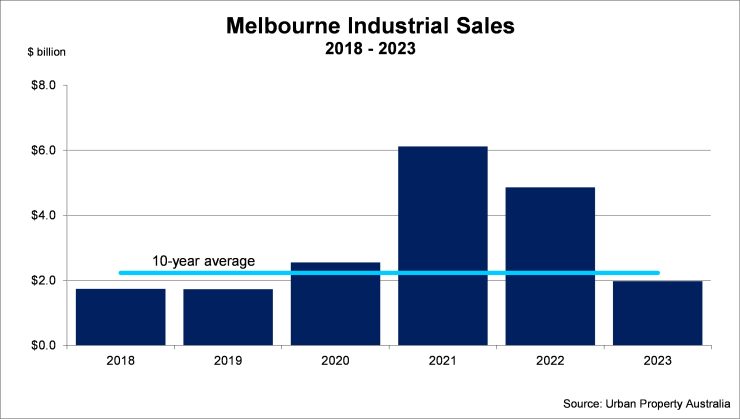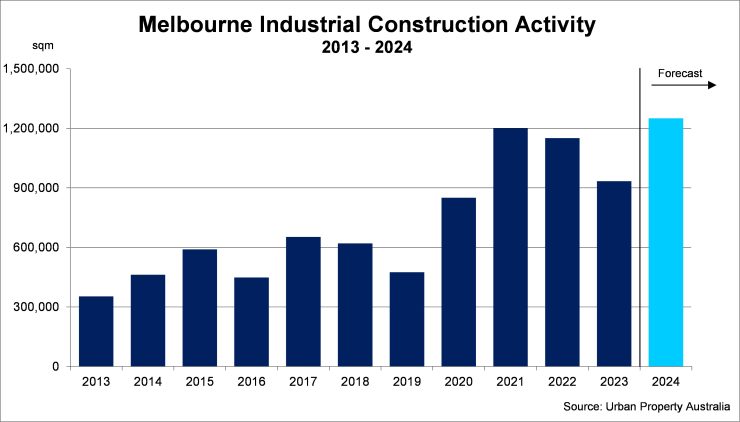Q4 2023 – Melbourne Industrial Market
February 1st 2024 | , Urban Property Australia
- Over 2023, $1.3 billion was transacted across the Melbourne industrial market led by the Western region, down 60% on the previous year’s levels;
- Industrial leasing activity in the Melbourne industrial market surpassed more than one million square metres over 2023, with transport and logistics occupiers accounting for 42% of take up of industrial space;
- Vacant industrial space across the Melbourne market continues to remain very low, as tenant demand outpaces new supply with Melbourne’s industrial vacancy rate currently stands at 1.2%.
Industrial Market Summary
With Melbourne industrial vacancy rate sitting at 1.2%, Melbourne industrial rents continue to increase with prime rents increasing by 13% over the year and secondary rents having increased by 11% as tenants struggle to source accommodation of all qualities. After two record-breaking years of transactional activity, investment volume in the Melbourne industrial market declined sharply in 2023, falling by 60% compared to last year, impacted by higher capital costs and buyers and sellers disconnected on pricing leading to yields easing.
Sales Volume/Yields
After two record-breaking years of transactional activity, investment volume in the Melbourne industrial market declined sharply in 2023, falling by 60% compared to last year, impacted by higher capital costs and buyers and sellers disconnected on pricing. Over 2023, $1.3 billion was transacted across the Melbourne industrial market led by the Western region. Although the introduction of the foreign owner land tax has created uncertainty in the transaction market, both offshore groups and domestic funds were active in the industrial transactional market in 2023. Impacted by the increased cost of capital, yields continued to ease with average prime industrial yields now sitting at 5.75% with average secondary yields moving out to 6.50%. Although the higher cost of debt has impacted yields, Urban Property Australia anticipates that yields will remain relatively steady looking ahead with interest rates projected to be steady.

New Supply/Land Values
For the fifth consecutive year, new industrial supply surpassed the long term average, with more than 900,000 square metres completed in the Melbourne industrial market in 2023 of which the majority was speculatively built. The Western region accounted for almost half the new stock delivered to the Melbourne market last year. Looking ahead, Urban Property Australia is projecting more than 1.2 million square metres to be completed in the Melbourne industrial market in 2024, which would be a record level. Once again, the Western region accounts for the bulk of new supply and vast majority of projects under construction commenced speculatively. Having increased substantially in recent years, average industrial land values have remained steady over the past year, which have been supported by rising rents despite yields softening.

Tenant Demand
Industrial leasing activity in the Melbourne industrial market surpassed more than one million square metres over 2023, with transport and logistics occupiers accounting for 42% of take up of industrial space. Boosted by the growing penetration of e-commerce and a growing importance of supply chain efficiencies, retailers and wholesale trade also remain prominent highlighted by Amazon’s commitment to its new 200,000sqm facility. The focus of the tenant demand in 2023 was in the Western region according to Urban Property Australia research.
Vacancy/Rents
Vacant industrial space across the Melbourne market continues to remain very low, as the growth of e-commerce has driven tenant demand outpacing new supply. Urban Property Australia research estimates that Melbourne industrial vacancy rate currently stands at 1.2% as at January 2024 with the North and East vacancy rates below 1%. Elsewhere, the vacancy rate of the South East region is 1.0% and the Western region standing at 1.2%.
While Melbourne industrial rents continue to increase, rates of growth have moderated by the level of speculative new supply which was delivered to the market over the past 12 months. Prime industrial rents have grown on average by 13% over the 12 months to January 2024 with secondary rents having increased by 11% as tenants struggle to source accommodation of all qualities. Prime rental growth was led by the South Eastern precinct. Urban Property Australia expects that while rents will continue to increase, the rate of rental increases will reflect the amount of supply to various regions as tenants seek facilities to accommodate supply chain requirements.
Copyright © 2024 by Urban Property Australia All rights reserved. No part of this publication may be reproduced in any form, by microfilm, xerography, electronically or otherwise, or incorporated into any information retrieval system, without the written permission of the copyright owner.



